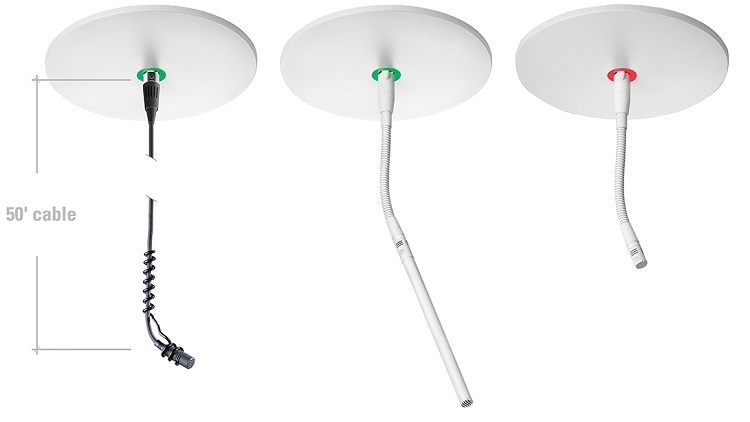“Is it plugged in?” has a whole new meaning in tech support these days. A connection to a network is as vital, and sometimes equivalent to, a power hookup. That’s the new baseline, and then once you’re plugged in, the next question is, what else can you plug in, and how can you use that connection to share more audio and video across a wider array of applications?
The latest round of networked AV products reveals the multifaceted nature of networked AV today. In addition to moving control signals, distributing audio and managing videoconferencing, there are new solutions that are adding more and more nuance to the network. From microphones through to PTZ cameras, hardware is not just connected, it’s operating on a multiplatform level to collect more audiovisual data and enable advanced collaboration from the desktop to the coffeeshop. Here’s a look at the new tools that will help tech managers gain access to more channels of audiovisual communications and deliver an info-rich experience to users.
1. SMART MICS ARE GETTING SMARTER.
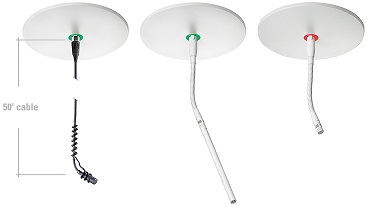
It’s getting easier to build an end-to-end networked audio system, with new Dante-enabled mics that eliminate the need for a separate, standalone audio interface. Audio-Technica has expanded its family of Dante-enabled microphones with two new ceiling-mount models, the ATND931 six-inch gooseneck and ATND933 hanging mic, which both come standard with the new ATND8734 Microphone Ceiling Mount Power Module with Dante Network Output. Powered by network PoE, these mics’ RJ45 connector provides plug-and-play access to the Dante audio network over CAT5e (or better) cable. To make things even easier, Audio-Technica has been working closely with industry-leading DSP manufacturers including Biamp, Symetrix and Bose to ensure Dante-compatible logic and remote control software integration for simple, flexible operation without the need for additional cabling. Both Dante mics are available with a selection of three polar patterns: cardioid, hypercardioid and MicroLine.
2. THE MEETING DOESN’T HAVE TO SOUND BAD.
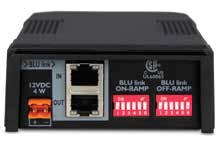
If web conferencing services are your game, and they probably are, then BSS by HARMAN can provide you with an affordable accessory that easily integrates any computer with the local conference audio system. The Soundweb London BLU-USB interfaces USB audio to BLUlink-enabled audio systems, allowing a PC or Mac to send audio to, and receive audio from, the BLU link bus. Able to simultaneously send and receive up to eight channels of audio, BLU-USB also helps to solve the distance limitations associated with USB transmission by converting audio to BLU link close to the source, which means the processor can be located in a different location up to 100 meters away.
3. THIS IS MORE THAN JUST A STANDALONE AUDIO DSP PRODUCT.
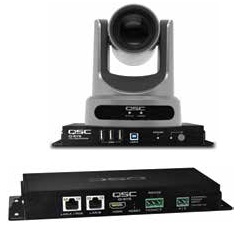
For the camera side of the soft codec revolution (and beyond), QSC is now providing an AV-to-USB Bridging solution, which pairs the Q-SYS I/O-USB Bridge and two PTZ-IP Conferencing cameras, the Q-SYS PTZ-12X72 and Q-SYS PTZ-20X60. Now it’s possible to use the Q-SYS AEC and cameras directly within the Q-SYS Designer Software to maximize PC-hosted soft codecs in meeting rooms. The Q-SYS AV–to-USB Bridging solution employs driverless USB 2.0 for webcam video emulation and AEC speakerphone audio. This means no additional software or drivers are required to make the solution work with PC operating systems and soft codec applications such as Skype for Business, ClickMeeting, Adobe Connect, GotoMeeting, WebEx and others.
4. IF EVERYTHING IS ONLINE, SHOULDN’T HARDWARE BE SMALLER?
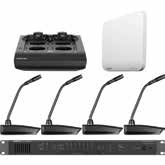
Seeing a lot of all-in-one videoconference solutions and huddle rooms popping up all around you? Need a smaller plug-and-play rechargeable wireless mic system to fit into a cramped space? Well, Shure Incorporated now offers a two-channel version of its Microflex Wireless System (MXW) with compact dimensions tailored to fit smaller-scale installations. Networked connectivity allows remote battery status monitoring and one-touch transmitter linking the new MXWNCS2 to Shure’s MXWAPT2 dual-channel Access Point Transceiver, or wireless mic routing hardware. Automatically coordinating clean frequency assignments, the transceiver also boasts a diminutive design. The, a dual-channel version of the existing four-and eight-channel networked charging stations, connects to the system over Ethernet and links docked microphones to Access Point Transceivers. The Microflex Wireless line addition also includes the introduction of updated firmware (version 4). In addition to making existing Microflex Wireless systems compatible with the new two-channel MXWAPT2 and MXWNCS2, the update enables users to establish a backup microphone that operates on the same audio channel as the main microphone.
5. IF IT’S ON THE NETWORK, YOU CAN SEE IT.

More sources and more video over IP means there’s a need for more flexibility in window processing. With the new SVSI NMX-WP-N1512 Windowing Processor from AMX by HARMAN, there’s no need to connect directly to the video sources—it’s all network based. Encoders are used to stream the video content on the network and the windowing processor can be located anywhere there is network access, including in the datacenter. The N1512 is a 1RU rack-mount appliance connects to an SVSI video over IP network and accepts up to four video streams as input. Each input can be cropped, scaled, and positioned according to stored presets (such as quad, window-in-window, 3+1, etc.) or in any user-defined configuration. The N1512 functions as a 4×1 windowing processor and can be stacked to give 7×1, 10×1, 13×1, 16×1, or higher capability. Network connectivity provides access to all available video streams for window selection and for output of the combined stream. To ensure legendary, visually stunning SVSI video output, the input and output video is compressed using the N1000 MPC codec, which uses a minimal amount of compression to provide excellent HD video quality at low latencies.
6. IS “INFOPRESENCE” THE NEW COLLABORATE?

When collaborators can’t be in the same room, but they have lots of visual content and data to share, they need infopresence. That’s the digital meeting room equivalent of meeting room collaboration tools, or as Oblong describes it, “A fully shared and unified experience among multiple users, devices, screens, and locations.” Oblong’s Mezzanine spatial interface is built to provide collaboration at scale and across distance, and now the platform’s newest enhancement, Mezz-In, provides a way for remote participants to upload, control presentations and share their screens all within the Mezzanine web client. The improvements enable collaboration for remote participants by integrating videoconferencing into the Mezzanine web client, and now external meeting participants have full visibility to the Mezzanine workspace and the ability to upload content and control presentations, with screen-sharing capabilities via Chrome.
7. WHAT ABOUT AN AUDIO-NETWORK FRIENDLY SWITCH?
Simple Dante networks are not difficult to set up and operate, but as network complexity grows, the switches used need to be optimized for Dante operation in order to achieve maximum stability. Setting up QoS, IGMP Snooping and other parameters on an intelligent switch can be a complex task. But with the new Yamaha Professional Audio SWP1 Series of L2 gigabit network switches, a Dante optimized setup of these parameters can be recalled by simply flipping one DIP switch. Also, the SWP1 Series includes three VLAN presets that can be selected via a DIP switch to set up independent VLAN domains to take full advantage of a network’s potential for handling StageMix or other Smart device functions. There is also a user mode that allows fully customized VLAN setup. And for those who prefer a more hands-on approach, the dedicated Yamaha Audio Network Monitor application for Windows provides a comprehensive view of parameters required for Dante network management including network traffic, switch status and individual Dante device information.
8. KEEP TRACK OF EVERY NEW THING THAT’S ON THE NETWORK.

Networked AV means bigger AV, and that means a tech manager might be handling a network of hundreds of ports. Well, Kramer has arrived with a platform that makes this task as easy as more traditional, smaller-scale AV operations. It’s called Kramer Network, and now with any laptop, PC or tablet, IT or AV managers can remotely configure, route, control and manage Kramer Pro AV devices, room environments and IP streaming devices via a user−friendly web-based interface. Kramer Network can be installed on standard, enterprise, virtual or cloud servers for management and control of the manufacturer’s entire AV and IP product range, as well as legacy AV, Dante, and other devices. The solution also supports API integration, which as we know, will be vital with the advent of the Internet of Things. Also in that vein, the platform features enhanced security with intuitive user−access management of specific audio or video sources, rooms and predefined scenarios. IT and AV managers can also easily monitor the system’s health status and track the connection between a source and a destination.
9. THE NETWORK ALSO BOOSTS ASSISTIVE LISTENING.
Now hearing loop systems can be deployed with greater efficiency and ease thanks to Listen Technologies’ new offering of its D Series Digital Signal Processing (DSP) network-controllable drivers with a Dante option for its ListenLoop system. ListenLoop, powered by Ampetronic, provides a personal listening experience to anyone with a telecoil technology in their hearing aid or cochlear implants without additional equipment. The Dante option improves audio transmission over Ethernet, and network/Wi-Fi connectivity and control eases the process of setting up a loop system as well as providing additional capabilities for remote control, maintenance and monitoring. The new D Series offerings consist of 10 and 14 Amp dual output drivers. Both drivers offer a more than 60-percent increase in energy efficiency over existing solutions.
10. PROJECTORS CONNECT TO CONTENT.
At its core, networked AV means ease of installation, especially where multitudes of projectors are concerned. The new Optoma ZU510T WUGXA DLP laser projector streamlines integration with a variety of inputs, including two HDMI and HDBaseT, allowing users to easily send and control AV content using a single CAT5 cable. Offering 5,500 lumens, the projector also fills a much needed hole in the mid-range of this product category. It includes a fixed lens with horizontal and vertical lens shift, offering a 1.2:1 - 2.16:1 throw ratio and a digital zoom of 1.8x, enabling it to cover a wide range of interchangeable lens capabilities without having the need to buy additional or change lenses.
11. WAIT A MINUTE! 4K NETWORKED VIDEO DISTRIBUTION FROM AN AUDIO COMPANY?

Yep, it happened. Biamp Systems has unveiled TesiraLUX, which brings low-latency, 4K networked video distribution to the Tesira platform, meaning it now transports both audio and video signals over a single network via AVB/TSN. Supporting the latest advancements in video formats, including 4096x2160 at 60Hz, high dynamic range (HDR) and the Rec. 2020 color space, TesiraLUX can accept video at up to 16-bit color depth with 4:4:4 chroma subsampling. It also supports 8-channels of embedded PCM audio which can be broken out to be routed and processed independently. The system also manages EDID automatically between the TesiraLUX device and the input source/output display thanks to scalers in both the encoder and decoder. By utilizing AVB/TSN, TesiraLUX guarantees a total system latency of less than two frames (33ms at 60Hz), including scaling, compression, and network transit. AVB/TSN bandwidth reservation capabilities coupled with TesiraLUX’s bandwidth management tools also sets up customers to create truly converged networks rather than dedicated AV media distribution network infrastructure.
12. WHAT ELSE CAN WE FIT IN THIS SYSTEM?

To help right-size all the new Dante product options for individual projects, Crown by HARMAN has introduced the DCi-DA Series amplifiers with Dante. The Crown DCi-DA Series consists of five amplifiers offering the most-popular combination of channel count and output power, joining Crown’s Analog, Network and Network Display Series to offer 25 different combinations of channel count, output power and feature set. In addition to being able to send and receive Dante audio, the DCi-DA Series includes many of the same features as the DCi-Network Series, such as the inclusion of a high-level DSP with JBL tunings, network control/monitoring and the ability to drive 2/4/8 ohm, 70V and 100V speaker loads out of each channel without the need for an external transformer.
13. DIGITAL SIGNAGE NEEDS AV NETWORKING, TOO.
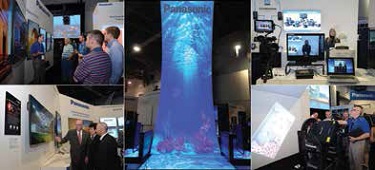
Panasonic’s new EF1 Series of 84-and 75-inch displays is built for self-contained or networked digital signage, or as an office/education/retail communication system. A USB media player features synchronized playback on multiple displays via USB and LAN, and multi monitoring and control software distributes content via the network. Additionally, Panasonic’s VF1H 700 cd/m2 flagship 55-inch display offers USB media updates over LAN for self-contained and more convenient signage solutions. HDBaseT-based DIGITAL LINK transmits audio, video and control signals to multiple displays via a single CAT-5e or Higher STP cable in daisy-chain configuration.
14. STUDIO-QUALITY SOUND COMES TO DIGITAL AUDIO NETWORKING.
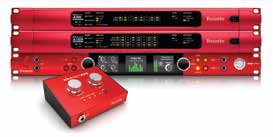
Studio recording expertise is elevating the networked audio space. Focusrite is offering a scalable, “near-zero” latency audio distribution system that can be used to expand I/O channel count, interface digital components and/or bridge between Pro Tools|HD or MADI and the Dante audio network. Known as RedNet, Focusrite’s flagship range of modular Ethernet-networked audio interfaces uses Dante to deliver studio-quality sound. Focusrite’s best is all in there: advanced A-D/D-A conversion, premium multi-layered board circuitry and JetPLL clocking deliver clean, transparent audio at a dynamic range of 119dB with 24-bit resolution at sample rates up to 192kHz.
15. ‘EMPOWER’ YOUR CONNECTED AV SYSTEM(S).
“The proliferation of small devices in AV installation is making it increasingly difficult for integrators to balance power demands with the space constraints and the small number of power outlets available to these systems,” said Scott Lowder, senior product manager of power at Middle Atlantic. That’s why the company created its DC Power Distribution, the a centralized DC power solution that solves the growing complexities in commercial applications. While Lowder mentions integrators in his comment, we know that this scenario affects tech managers, too. The new Middle Atlantic unit eliminates messy, space-consuming “wall warts” and other power clutter with a universal power solution for DC-powered devices. With mounting options for all size models, DC Power Distribution products are available as 45W DC compact and 125W DC 1RU systems, allowing the system to fit anywhere, including typical rack units, small enclosures, and wall boxes. It’s designed with a color-coded screw terminal connector platform and polarity labeling for its 5V, 12V, 18V, and 24V outputs. DC Power Distribution ships with everything you need in the system’s hardware kit. The solutions also offer multi-level protection on both AC input and DC outputs, USB ports to power compatible products, and AC convenience outlets on the 45W model. Oh, and, don’t forget about the nice bonus of the LED indicators. These lights show activity on each output and alert users to maximum capacity on each voltage bank.
